Lithofacies architecture and palaeogeography of the Late Paleozoic glaciomarine Talchir Formation, Raniganj Basin, India
Deprtment of Geology, Presidency University, 86/1, College Street, Kolkt-700073, Indi
b Department of Earth Sciences, Indian Institute of Technology, Roorkee, Uttarakhand-247667,India
KEYWORDS Late Paleozoic,Talchir Formation,Raniganj Basin,glaciomarine sedimentation,facies architecture,sequence stratigraphy
Abstract Talchir Formation (Permo-Carboniferous) of the Gondwana Supergroup records the Late Paleozoic glaciation in Peninsular India. Talchir sedimentary succession of the Raniganj Basin, Damodar Valley Coalfields, Peninsular India, bears ten facies types grouped under three facies associations, viz., the proglacial conglomerate-sandstone facies association (CS), the foreshore-shoreface conglomerate-sandstone-mudstone facies association (CSM) and the prodelta-shelf sandstone-mudstone facies association (SM). Overall facies architecture reflects initial ice-covered terrestrial subglacial sedimentation, which was subsequently reworked and emplaced subaqueously in front of the ice-grounding line, and finally overlapped by storm-laid prodelta-shelf sediments. Repeated glacial advance-retreats with shifts in the position of the ice-grounding line during phases of climatic amelioration led to multiple deglaciation-related fining-up cycles. Decoupled ice sheet and floating icebergs contributed icerafted debris (IRD) to these sediments. Gradual retreat of the ice sheet, however, restricted the supply of IRD towards top of the succession. Overlap of wave-agitated shoreface-shelf sediments on the glaciogenic sediments indicates widespread marine transgression caused by glacier melting during ice-house to green-house climatic transition, and crustal downsagging related to glacioisostasy. Subsequently, complete disappearance of the ice sheet caused basinal exhumation along with crustal uplift due to isostatic rebound, leading to multiple horst-graben bounded basinal systems, which received post-Talchir coal-bearing Gondwana sediments.
1 Introduction
Sedimentation in glaciomarine environments results in highly variable facies architecture (Bhattacharya and Bhattacharya, 2007; Bhattacharya et al., 2005; Bose et al.,1992; Brodzikowski and van Loon, 1987; Domack et al.,1980; Dowdeswell et al., 1994; Evans et al., 2006; Eyles et al., 1985, 1998, 2003, 2006; Fielding et al., 2008; Jin,2002; Jones and Fielding, 2004; Lajeunesse and Allard,2002; L?nne, 1995; Mukhopadhyay and Bhattacharya, 1994;Plink-Bj?rklund and Ronnert, 1999; Poulsen et al., 2007;Rygel et al., 2008; Syvitski et al., 1996; and many others).Icehouse-greenhouse climatic transitions and glacioisostasy-induced tectonism are the dominant forcing mechanisms that dictate the sedimentation patterns and succession motifs of ice-marginal shelves (Powell and Cooper, 2002). Modern glacial theory validating multiple examples of recent glaciated terrains from the world over signifies the role of glacial isostatic adjustments (GIA) in changing relative sea level (RSL) and controlling the morphology of ice marginal coastal/deltaic settings (Aber and Lundqvist, 1988; Bassett et al., 2005; Bhattacharya et al., 2005; Milne, 2002; Peltier,1999; Whitehouse et al., 2007). Signatures of sea-level fluctuations in response to glacial advances and retreats can be used to define glacial system tracts bounded by sequence boundaries (Powell and Cooper, 2002). Thus, parasequences of glacial system tracts control the stratigraphic architecture of many ancient and present glaciomarine successions(Powell and Cooper, 2002; Whitehouse et al., 2007). So,in ice-marginal shelves, glacial sequence stratigraphy with records of temporal variations in local water depth manifest glacial fluctuations with changes in glacioeustatic and glacioisostatic forcings during sedimentation (Powell and Cooper, 2002; Visser, 1997).
Coal-bearing sediments of the Gondwana Supergroup(Late Carboniferous to Early Cretaceous) occur in a number of isolated basins along several palaeo-rift valleys in Peninsular India. Talchir Formation (Permo-Carboniferous), the lowermost stratigraphic unit of the Gondwana Supergroup,bears evidences of Late Paleozoic glaciation in Peninsular India and is interpreted as a glacial, glaciofluvial or glaciolacustrine deposit (Banerjee, 1966; Ghosh and Mitra, 1975).Recent sedimentological analyses of the Talchir sediments from the Damodar Valley coalbasins (e.g., West Bokaro Basin, Jayanti Basin, Saharjuri Basin, Raniganj Basin) and Mahanadi Valley coalbasins (e.g., Talchir Basin) recorded deposition in storm-tide influenced shallow marine settings over basal glaciogenic sedimentation (Bhattacharya, 2003,2013; Bhattacharya and Bhattacharya, 2006, 2007, 2010,2011, 2012, 2014; Bhattacharya et al., 2002, 2004, 2005,2009; Bose et al., 1992; Chakraborty and Bhattacharya,2005; Mukhopadhyay and Bhattacharya, 1994).
The Talchir Formation (Permo-Carboniferous) of the Raniganj Basin, India was previously interpreted as glaciolacustrine sediments (Banerjee, 1966; Ghosh and Mitra,1975). Bhattacharya et al. (2004), Bhattacharya and Bhattacharya (2006, 2007) re-evaluated the Talchir Formation as ice-marginal shallow marine sediments deposited under a tide-storm interactive system. The present paper provides detailed facies description of the glaciomarine Talchir Formation of the Raniganj Basin and interpretations within the framework of different glacial-marine processes. The facies sequences are subsequently divided into several glacial system tracts depending on the evidence of glacial advances and retreats. This contribution attempts to relate the glacial sequence stratigraphic architecture of the studied Talchir sediments with the sedimentation patterns of glaciated shelves. Such an attempt to relate the palaeogeographic-palaeoclimatic conditions with glacial advance-retreat cycles and glacial isostatic adjustments(GIA) in light of modern glacial theory has not been previously attempted from these successions, and will enhance the understanding of the Late Paleozoic Gondwanaland-Tethyan system.
2 The Raniganj Basin
Coal-bearing continental sediments of the Gondwana Supergroup (Late Carboniferous-Early Cretaceous) rest unconformably on Precambrian country rocks in some isolated fault-bound basins, distributed along three major linear river valleys in Peninsular India (Veevers and Tewari, 1995)(Fig. 1). Among these basins, the Raniganj Basin is known for a thick (more than 4000 m) succession of coal-bearing Gondwana sediments (cf., Bhattacharya and Bhattacharya,2006, 2007; Bhattacharya et al., 2004; Ghose, 2002; Ghosh and Mitra, 1975; Veevers and Tewari, 1995). The Talchir Formation, the basal unit of the Gondwana Supergroup, is exposed along the northwestern margin of this basin and overlies the southerly dipping granitoid basement of Precambrian age (Fig. 1). Continuously-exposed sections of the Talchir sediments are available along some river courses,specifically, the Madhoraidih River, Barakar River and Ajay River (Figs 1, 2). Patchy exposures of Talchir sediments are also available along the Sonbad River and the Dharma River.The unconformable contact between the Talchir sediments and the granitoid basement is exposed along the Ajay River section (Fig. 3A). In other sections, the contact between the Talchir sediments and basement granitoids is represented by basin-marginal cross-faults (Figs 1, 2). The Madhoraidih River section represents a near-complete succession (~400 m thick) of the Talchir Formation (Fig. 2). The average dip of the Talchir beds is 14° towards SSW. The basin opens towards south, where sediments of the Karharbari Formation and other coal-bearing younger Gondwana Formations overlie the Talchir succession (Fig. 1).
3 Lithofacies architecture
Detailed lithofacies analysis of the Talchir sedimentary succession of the Raniganj Basin reveals ten lithofacies types that are grouped into three major facies associations,viz., conglomerate-sandstone facies association (CS), conglomerate-sandstone-mudstone facies association (CSM)and sandstone-mudstone facies association (SM). Sedimentary logs showing the facies architectures of each facies association and their correlation along the major river sections are presented in Figure 2.
3.1 Conglomerate-sandstone facies association
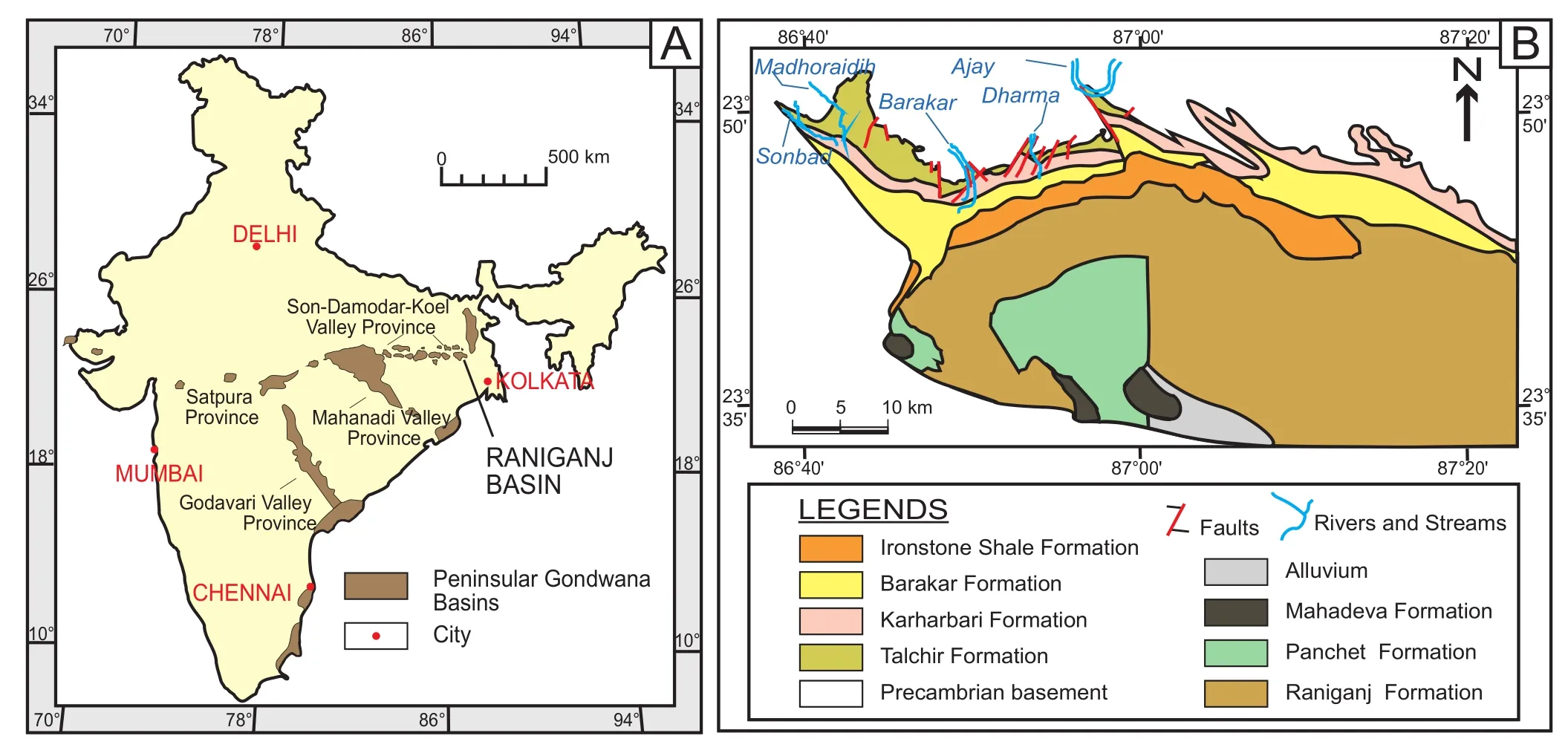
Figure 1 A-Map showing distribution of Gondwana provinces in Peninsular India. Note the location of the Raniganj Basin; B-Generalized geological map of the Raniganj Basin showing different litho-units (modified after Ghosh and Mitra, 1975).
The conglomerate-sandstone facies association (CS)is represented by matrix-supported conglomerate facies(CS-1), hummocky cross-stratified sandstone facies (CS-2)and conglomerate-sandstone alternations facies (CS-3).
The matrix-supported conglomerate facies (CS-1) rests unconformably on the granitoid basement, with an uneven and sharp contact (Fig. 3A). The conglomerate is disorganized, matrix-supported with angular to rounded clasts(average size is ~10.2 cm, as measured from the longest diameter of 67 clasts on field) of granite, quartzite, amphibolite and a few rip-up clasts of the Talchir shale (Fig.3B). Faceted and striated clasts and bullet-shaped pebbles are abundant (Fig. 3C). Just below the conglomerate bed,subparallel glacial striations on the basement trend SE-NW(mean 167°-347° of 12 measurements) (Fig. 3D). Each conglomerate grades upwards to crudely stratified current ripple laminated sandstone-mudstone interbeds (palaeocurrent direction S-SW) (Fig. 4A, 4B). Complex slump folds(Fig. 4C) and syn-sedimentary deformation structures like upward flowage of sand/mud through small fault planes(Fig. 4D) are common within the sandstone-mudstone interbeds. The hummocky cross-stratified sandstone facies(CS-2), sandwiched between two successive conglomerate beds (of CS-1), is represented by thick sandstone beds characterized by hummocky-swaley cross-stratification near the base (Fig. 5A) and followed upwards by plane laminations and wave ripple cross-laminations. Lower contacts of such sandstone beds are sharp, while the overlying conglomerate beds truncate the upper contact. The conglomerate-sandstone alternations facies (CS-3) consists of couplets of sharp based, inversely graded, pebbly conglomerate grading upwards to massive sandstone (Fig. 5B). Outsized clasts are common in all the facies (Figs 3A, 4C, 5B).
The matrix-supported conglomerate (CS-1) represents subglacial meltwater-laden debris flow deposits, emplaced subaqueously near the basin-marginal part. Liquefaction and peripheral fluidization due to water intake fluidized the cohesive debris flow and caused gradation of the chaotic fabric to crude stratifications towards the top. The hummocky cross-stratified sandstone (CS-2) represents deposition from a waning storm surge (cf. Dott Jr. and Bourgeois,1982; Kreisa, 1981). The conglomerate-sandstone alternations facies (CS-3) are formed by glaciogenic sediment gravity flows that were subsequently reworked by different sedimentary processes during phases of repeated retreats and readvances of the glacier (cf., Bhattacharya et al., 2005). Development of dispersive pressure within the sediment gravity flow resulted in reverse grading within the conglomerate (Bagnold, 1954; Carter, 1975; also see, Mukhopadhyay and Bhattacharya, 1994). Slump folds and softsediment deformation structures are produced by liquefaction/fluidization triggered by the shear drag/load exerted variously on unconsolidated sediments. In ice-marginal setting, however, such load/shear drag may have been exerted by the overriding ice-mass during phases of glacial readvances (Bhattacharya et al., 2005; also see, Bhattacharya and Bhattacharya, 2010).
3.2 Conglomerate-sandstone-mudstone facies association
The conglomerate-sandstone-mudstone facies association (CSM) overlies the sediments of the conglomeratesandstone facies association (CS) and is represented by thinly bedded sandstone-mudstone interbedded facies(CSM-1), graded sandstone-siltstone facies (CSM-2), clastsupported conglomerate facies (CSM-3), thickly bedded sandstone-mudstone interbedded facies (CSM-4) and dropstone-bearing mudstone facies (CSM-5). The boundary between conglomerate-sandstone facies association (CS) and its overlying conglomerate-sandstone-mudstone facies association (CSM) is sharp.
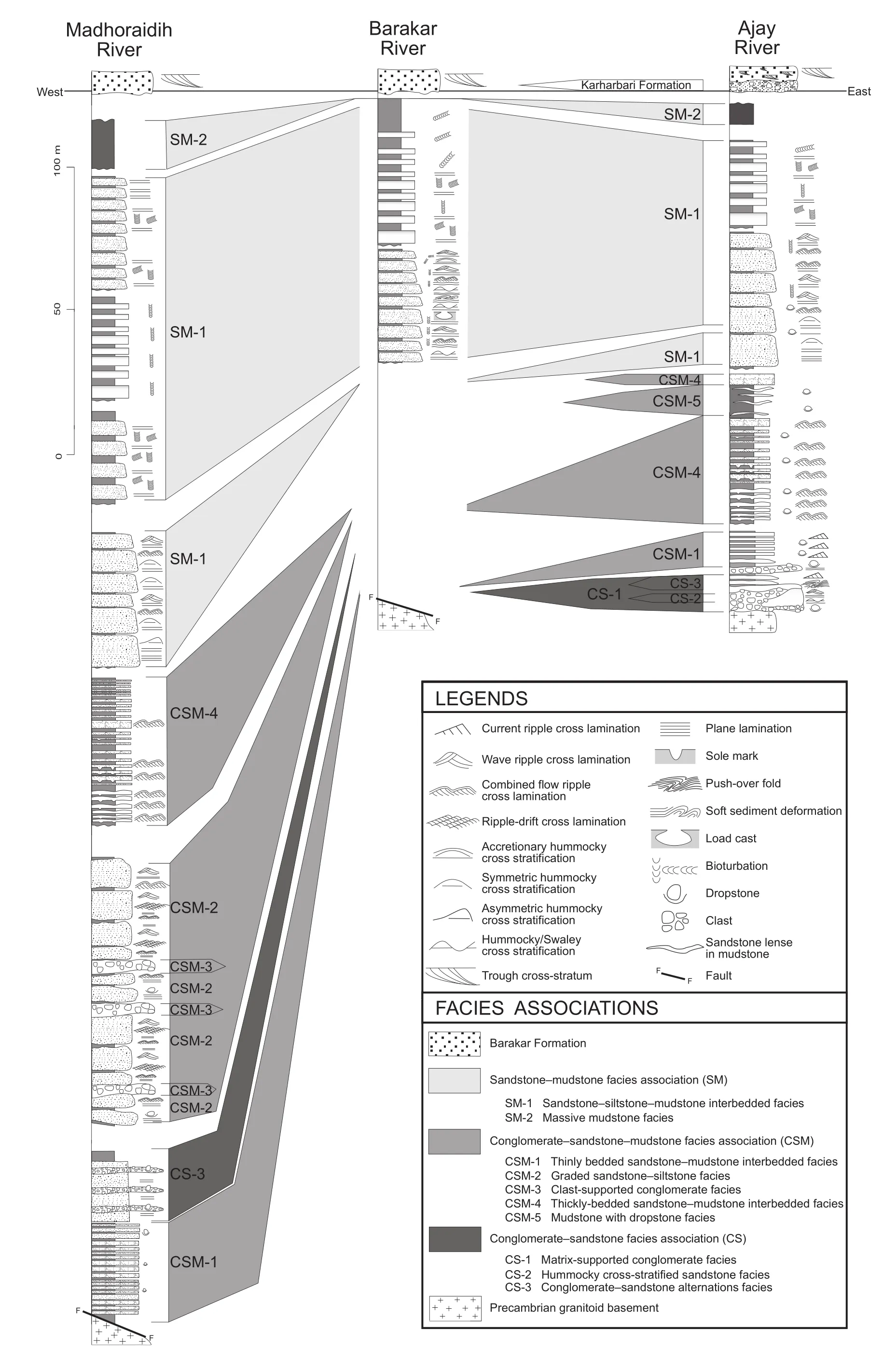
Figure 2 Vertical sedimentary logs of Talchir Formation and their correlation along the major stream sections in Raniganj Basin.

Figure 3 A-Matrix-supported conglomerate (Cg) unconformably (dashed line) overlies the Precambrian granitoid basement (G), Ajay River section. Note the presence of dropstone (D). Length of the hammer is 30.5 cm; B-Chaotic matrix-supported conglomerate (in plan view) with angular and rounded clasts of granite, quartzite and amphibolite, Ajay River section. Diameter of the coin is 3.2 cm; C-Bulletshaped clasts (in plan view) within the chaotic matrix-supported conglomerate (CS-1), Ajay River section. Diameter of the camera lens cover is 4.5 cm; D-Glacial striations (arrows) on the Precambrian basement (G), Ajay River section. Note that the conglomerate (Cg) lies unconformably over the basement. Length of the pen is 14.2 cm.
The thinly bedded sandstone-mudstone interbedded facies (CSM-1) is characterized by thin (cm-mm thick) sandstone/siltstone and mudstone interbeds (Fig. 6A). The lower contact of the sandstone/siltstone beds is sharp while the upper contact with overlying silt-streaked mudstone is gradational. The sandstone/siltstone beds are characterized by laterally accreted cross-strata bundles with intermittent reactivation surfaces (Fig. 6B), vertically accreted stratal bundles, rare bi-directional cross-bed azimuths (Fig. 6C)and sigmoidal cross-strata, and are generally covered by over thickened silty-mud drapes with wavy/hummocky laminae (Bhattacharya and Bhattacharya, 2006). The channelfilling graded sandstone-siltstone facies (CSM-2) is sharp based and shows normal grading of grain size from coarse sand to silt (Fig. 6D). Thickness of such graded beds varies from 5 cm to 20 cm. Hummocky cross-stratification, plane laminations, ripple-drift cross-laminations, combined-flow ripples and wave ripple cross-laminations are present within sandstone beds. Gutter casts, groove marks, prod marks,bounce marks and load casts are common at the sole of the sandstone beds. Thin (12 cm-28 cm), lenticular beds of clast-supported conglomerate facies (CSM-3) (Fig. 7A)often underlie/overlie these graded sandstone-siltstone beds. The conglomerate commonly shows reverse grading near the base and chaotic fabric near the top. Rounded clasts of granite, quartzite, amphibolite and a few rip-up clasts of Talchir shale are abundant within the conglomerate. Repeated occurrences of CSM-2 over CSM-3 resulted in several fining-up cycles (Fig. 2). The thickly bedded sandstone-mudstone interbedded facies (CSM-4) overlies this succession and is characterized by thick (30 cm-125 cm)well-sorted, coarse-grained, massive sandstone interbedded with thick (20 cm-115 cm) silt-streaked mudstone (Fig.7B). The thick sandstone beds with sharp and flat bounding surfaces characteristically lack any signatures of wave reworking. However, in relatively thinner beds, combined flow ripples are rarely preserved. Outsized clasts are locally present showing deformation in the underlying beds(Fig. 7B). Gutter casts (S-SW trending) and load casts are present on the bottoms of the sandstone beds. Near the base, the sandstone contains rip-up mud clasts. Locally, the top part of the sandstone beds is bioturbated with Cylin?drichnus (Fig. 7B; also see, Bhattacharya and Bhattacharya, 2007) and large Rhizocorallium jenense. Dropstonebearing mudstone facies (CSM-5) overlies the thick-bedded sandstone-mudstone interbedded facies (CSM-4) and is represented by silt-streaked laminated mudstone (Fig. 7C).Thickness of mudstone beds varies from <10 cm to >3 m.Dropstones are common in these sediments (Fig. 7B, 7C).
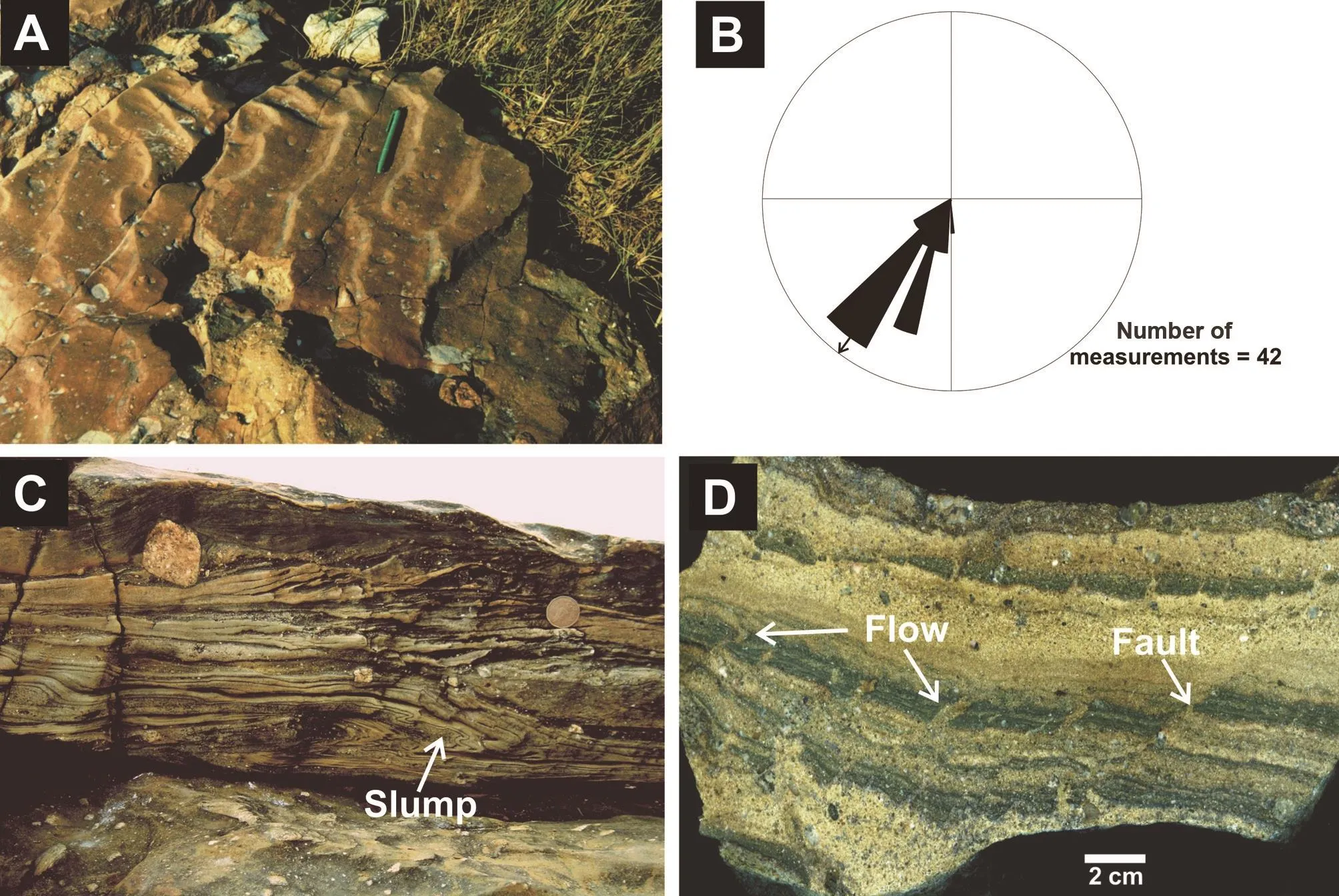
Figure 4 A-Current ripples on top of the sandstone beds near the top of CS-1, Ajay River section. Length of the pen is 14.2 cm; B-Rose diagram showing the palaeocurrent directions measured from the current ripples; C-Slump folds within fine-grained sandstone of the hummocky cross-stratified sandstone facies (CS-2). Note the presence of large dropstone near the top. Diameter of the coin is 2.6 cm;D-Polished slab showing soft-sediment deformations including faults and upward flowage of sand-silt within thinly laminated sandstonemudstone interbeds near the top of the chaotic matrix-supported conglomerate (CS-1).

Figure 5 A-Hummocky cross-stratified sandstone facies (CS-2) from Ajay River section, showing plane laminations (P), hummocky (H) and swaley (S) cross-stratification within fine-grained sandstone. The sandstone is underlain and overlain by the conglomerate (Cg) of CS-1.Length of the pen is 14.5 cm; B-Conglomerate-sandstone alternations (CS-3), Ajay River section. Note the presence of large dropstone (D)near top, and soft-sediment deformation structures (arrow marked) within the sandstone beds. Length of the dropstone is 46 cm.
Facies architecture in this facies association resembles closely that of the “shoreface facies assemblages”described by Mukhopadhyay and Bhattacharya (1994) and Bhattacharya et al. (2005) from Talchir Formation of the West Bokaro Basin, India. The thinly-bedded sandstonemudstone interbedded facies (CSM-1) is the result of deposition from fair weather tidal currents, which were intermittently reworked by marine storm surges (Bhattacharya and Bhattacharya, 2006; Bose et al., 1997). Channel-filling graded sandstone-siltstone facies (CSM-2) with characteristic primary structural elements signifies sedimentation in the rip current channels within the shoreface-foreshore zone (cf. Mukhopadhyay and Bhattacharya, 1994; also see,Bhattacharya et al., 2004). The channel-filling sediments
were mostly deposited above wave base (cf. De Raaf et al., 1977). Signatures of reworking of these sediments by subsequent storm surges are evident. The lenticular clastsupported conglomerates (CSM-3) indicate emplacement of surges of different sediment gravity flows of reworked-glaciogenic materials during glacier melting (cf., Bhattacharya et al., 2005; Mukhopadhyay and Bhattacharya, 1994).Multiple fining-upward cycles, produced by the conglomerate at the base and fine sandstone-siltstone (of CSM-2)towards the top, represent deglaciation sequences (Fig. 2)(cf. Visser, 1997; also see Bhattacharya et al., 2005). These deglaciation cycles attest to several advances-retreats of the ice front. The massive sandstone beds of CSM-4 are the products of rapid dumping of sand due to flow unsteadiness in collapsing, single surge-type high-density turbidity currents (Walker and Mutti, 1973). The turbidite-like appearance of the sandstone-mudstone interbeds (of CSM-4) indicates their deposition below storm wave base, where the storm surges behave as high-density turbidity currents (Myrow et al., 2002; also see, Bhattacharya and Bhattacharya,2007). The dropstone-bearing mudstone facies (CSM-5) are interpreted as storm-laid prodelta-shelf sediments deposited in a barred marginal-marine setting during the slack phases of successive storm surges (cf. Bose et al., 1992).Dropstones in these facies suggests the presence of floating icebergs in the ice-marginal sea.
3.3 Sandstone-mudstone facies association
The sandstone-mudstone facies association (SM) overlies the sediments of CS and CSM with sharp contacts.Sandstone-siltstone-mudstone interbedded facies (SM-1)and massive mudstone facies (SM-2) constitute this facies association. The sediments of this facies association can be clearly distinguished from the underlying sediments of CS and CSM by a marked decrease in grain size, thinness of beds, increased proportions of mud fragments, complete lack of ice-rafted debris (IRD) and abundance of bioturbation.
The sandstone-siltstone-mudstone interbedded facies(SM-1) is represented by alternating beds of thin (≤20 cm thick) sandstone/siltstone and mudstone. The sandstone/siltstone beds are characterized by the typical arrangement of various primary stratifications, including plane laminations (Fig. 8A), hummocky cross-stratifications (Fig.8A), accretionary hummocks (Fig. 8B, 8C), combined-flow ripples with ripple-drift cross-laminations and wave ripples (Fig. 8D). Thickness of the sandstone/siltstone beds decreases towards the top. The mudstone, which gradationally overlies the sandstone (Fig. 9A), is silt-streaked laminated. Sediments are, in general, moderately to highly bioturbated, mostly by endobenthic annelids, worms,crustaceans and a few molluscs (Bhattacharya and Bhattacharya, 2007). The thick, dark, massive or locally thinly laminated mudstone of the massive mudstone facies(SM-2) often underlies/overlies the sandstone-mudstone interbeds of SM-1 (Fig. 9B). The sediments of this facies association characteristically lack any dropstone or icerafted debris (IRD).
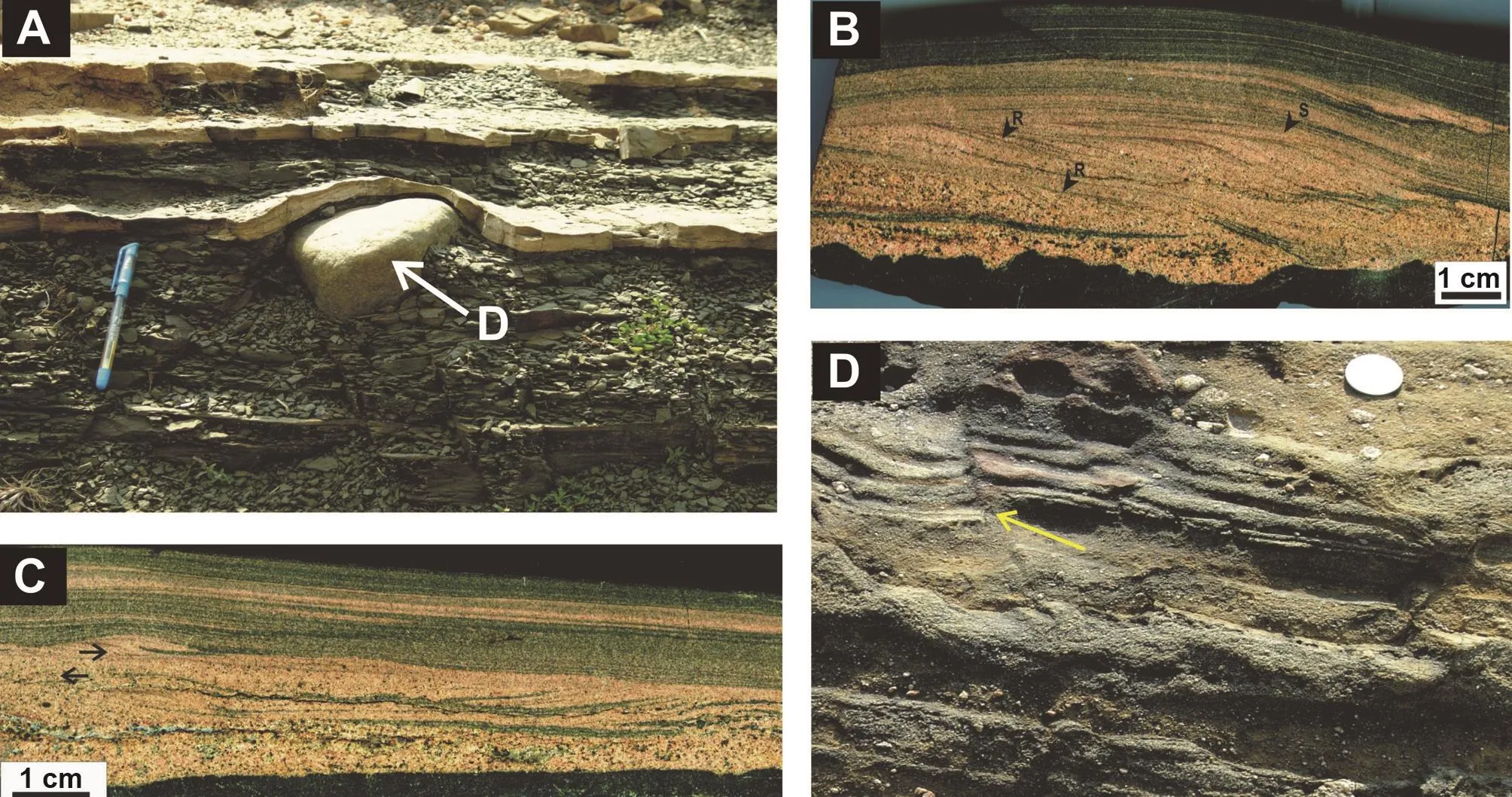
Figure 6 A-Thinly-bedded sandstone-mudstone interbedded facies (CSM-1), Ajay River section. Note the presence of outsized clast (D).Length of the pen is 12.6 cm; B-Polished slab showing laterally accreted cross-strata bundles with reactivation surfaces (R) and sigmoidal laminations (S) within the sandstone beds of CSM-1; C-Polished slab of CSM-1 showing cross strata with apparent opposite foreset orientations (marked with arrow) within vertically accreted sandstone layers; D-Coarse-grained sandstone grades normally to fine-grained siltstone within the graded sandstone-siltstone facies (CSM-2). Note the presence of syn-sedimentary faults (arrow). Diameter of the coin is 3.5 cm.
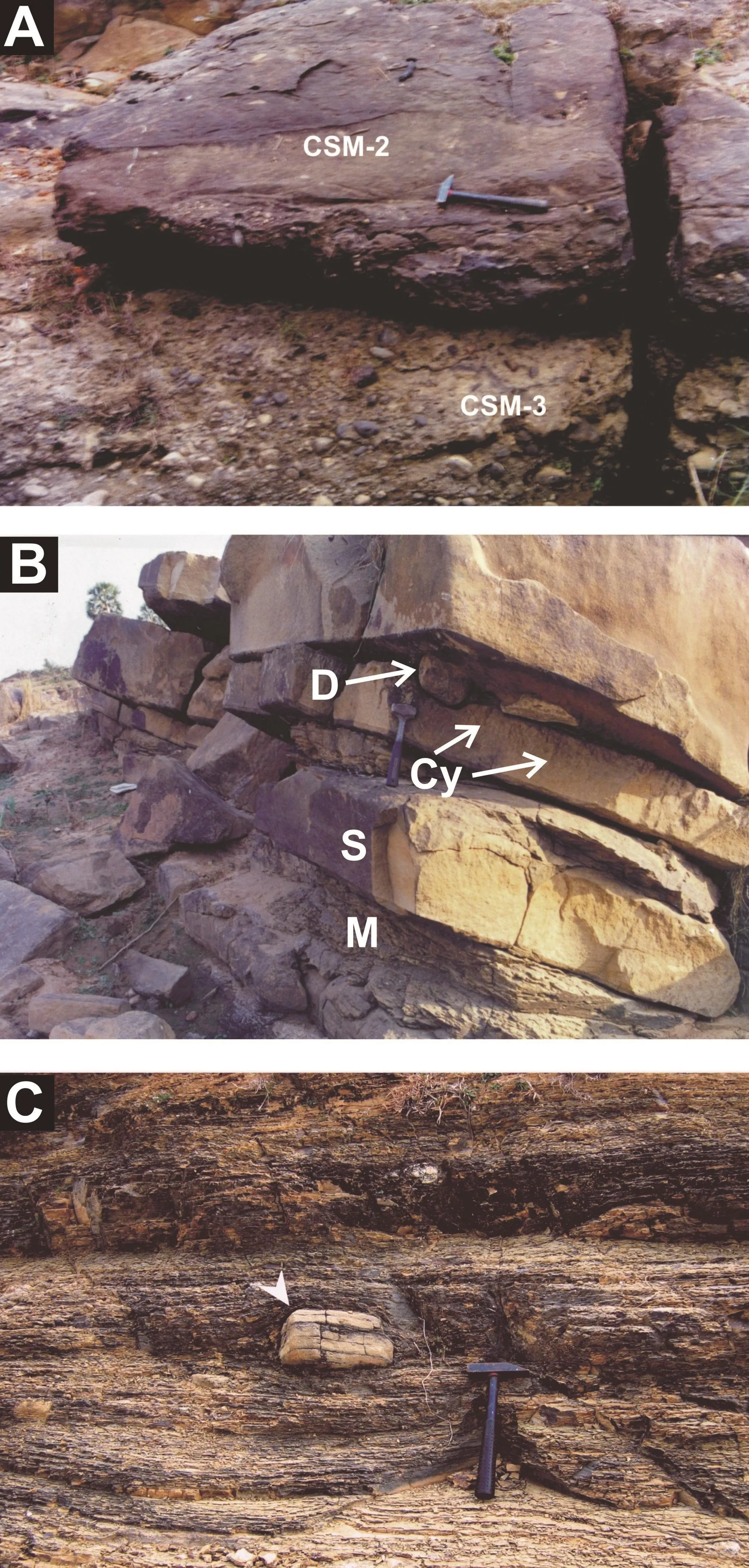
Figure 7 A-Lenticular beds of the clast-supported conglomerate facies (CSM-3), overlain by the graded sandstone-siltstone facies (CSM-2). Length of the hammer is 30.5 cm; B-Exposure of the thick-bedded sandstone-mudstone interbedded facies(CSM-4) along the southern bank of the Ajay River, showing thick beds of sandstone (S) with alternating mudstone (M) beds (of CSM-4). Cylindrichnus (Cy) occurs near the top of the sandstone beds. Note the presence of outsized clasts (D) with deformation at its base. Length of the hammer is 30.5 cm; C-Exposure of mudstone with dropstone facies (CSM-5), Ajay River section. Note the presence of outsized clasts (arrow marked), with minor sagging of the laminae below the clast and convexing up of the overlying laminae. Length of the hammer is 30.5 cm.
The facies architecture of this facies association bears close similarity with the architecture of “prodeltashelf facies assemblages” (Bhattacharya et al., 2002;Chakraborty and Bhattacharya, 2005). The sandstone-siltstone-mudstone interbedded facies (SM-1) is interpreted as storm-laid sediments deposited within and/or beyond storm wave base (cf. Bhattacharya et al., 2002, 2004,2009; Mukhopadhyay and Bhattacharya, 1994). Fining-up sequences within sandstone-mudstone couplets represent waning of storm energy (cf. Kreisa, 1981). The massive mudstone (of Facies SM-2) is inferred as autochthonous sediments deposited in the offshore part of the basin. Lack of dropstones and IRD in these sediments indicates a recession in ice-rafting as well as absence of floating icebergs in the Talchir Sea.
4 Palaeoenvironmental implications
From the lithofacies analysis of the studied Talchir sediments and their lateral and vertical distribution patterns,the following points can be summarized:
1) Subglacial melt water-laden sediments and reworked glaciogenic sediments are preserved near the basal part of the Talchir Formation (CS-1 and CS-2, belonging to the conglomerate-sandstone facies association), and represent shifting of the ice-grounding line in response to repetitive glaciation-deglaciation cycles during climatic amelioration.
2) The glaciogenic sediments were subsequently reworked by open marine storm surges during the interglacial phases. As a result, storm-influenced shoreface-shelf sediments (CSM-1, CSM-2, CSM-4 and CSM-5, belonging to the conglomerate-sandstone-mudstone facies association)onlapped the proximal glaciogenic sediments in response to an overall rise in sea level. Intermittent emplacements of the reworked sediment gravity flow deposits (CSM-3) mark the onset of new deglacial cycles.
3) Deposition of storm-derived basin-marginal prodelta-shelf sediments (SM-1, belonging to the sandstonemudstone facies association) from successive waning storm surges in the transgressive open sea, followed by burial under autochthonous offshore sediments (SM-2) demarcates termination of Talchir sedimentation.
4) Fluvio-lacustrine sediments of the Karharbari/Barakar Formation are deposited following Talchir sedimentation.
5 Primary sedimentary structures and their implications
Sequential arrangement of different primary sedimentary structures, viz., hummocky cross-stratifications (HCS),accretionary hummocks, plane laminations, combined-flow ripples with ripple-drift cross-laminations and wave ripple cross-laminations, produced different stratification architecture within the storm-laid Talchir sediments. Thicker(>50 cm) storm beds near the lower-middle part of the studied successions are characterized by normal gradingplane laminations-large HCS, while relatively thinner storm-laid beds contain plane laminations-smaller HCS/accretionary hummocks-combined-flow ripples. These are succeeded upwards by thinner sandstone/siltstone beds that bear plane laminations-wave ripples as the characteristic stratification architecture. The waning nature of the storm surges is, thus, depicted by the upward shift of top-truncated sequences to bottom-truncated sequences.Near-complete storm sequences (BPHFXM of Dott Jr. and Bourgeois, 1982; Walker et al., 1983) are present in the Ajay River section (Fig. 5A).
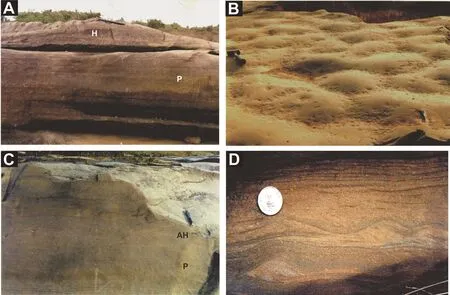
Figure 8 A-Plane laminations (P) followed by large hummocky cross-stratification (H) within amalgamated sandstone beds of the sandstone-siltstone-mudstone interbedded facies (SM-1), Barakar River section. Length of the hammer is 30.5 cm; B-Exposed top surface of small accretionary hummocks within sandstone-siltstone-mudstone interbedded facies (SM-1), showing extensive bioturbation in the trough areas. Length of the hammer is 30.5 cm; C-Accretionary hummocks (AH) in vertical section, showing their development over plane laminations (P). Length of the pen is 14.6 cm; D-Wave ripple cross-laminations developed within the sandstone-siltstone-mudstone interbedded facies (SM-1), Barakar River section. Diameter of the coin is 2.5 cm.
Thick storm-laid sandstone beds also contain various sole marks, viz., gutter casts (straight or curved with flat,rounded or stepped bases, and predominantly oriented perpendicular to the trend of the wave ripple crests; Fig.10), flute casts, groove marks (rectilinear, curvilinear or recurved/turn-about; oriented sub-parallel/oblique/orthogonal to major gutter axis; Fig. 10), bidirectional prod marks and bounce marks (Fig. 10) (also see, Bhattacharya et al.,2004).
The wide range of primary sedimentary structures manifests different phases of the mutual interaction of three storm-induced flows, viz., shore-parallel geostrophic flows,shore-normal wave oscillations and offshore-directed density-induced flows, along the Talchir shelf (Banerjee, 2000;Banerjee and Jeevankumar, 2007; Bhattacharya, 2013;Bhattacharya and Bhattacharya, 2011; Bhattacharya et al., 2004; Myrow and Southard, 1991, 1996; Myrow et al.,2002; Sarkar et al. 2002). Storm-laid wave ripples depicts the trend of the palaeoshoreline as NW-SE, while various sole marks and primary stratifications manifest probable SSE→NNW-ward storm invasion with offshoreward sediment dispersal towards the SSW (see Bhattacharya et al., 2004).Chance preservation of shore-parallel sole marks produced by geostrophic flows at the early stages of storm evolution signifies sufficient dampening of the storms on muddy,low-gradient shelf (cf., Beukes, 1996; Bhattacharya, 2013;Bhattacharya and Bhattacharya, 2010, 2011; Bhattacharya et al., 2004; Sarkar et al., 2002).
Dampening of storms also allowed local preservation of tidal sediments (within CSM-1) in a low-energy tidal embayment (Bhattacharya and Bhattacharya, 2006). Tidal sediments are generally covered by over-thickened siltymud drapes with wavy/hummocky laminae (Fig. 6B). Such silty-mud drapes attest to the signature of wave reworking during flooding by dampened storms along tide-dominated littoral settings (Coleman and Gagliano, 1965; also see,Bhattacharya and Bhattacharya, 2006). The changeover from storm-laid mudstone to tide-generated thin sandstone beds records gradual shoaling. Stacking of sandmud interbeds indicates repeated storm flooding and subsequent shoaling phases (see Bhattacharya and Bhat-tacharya, 2006).
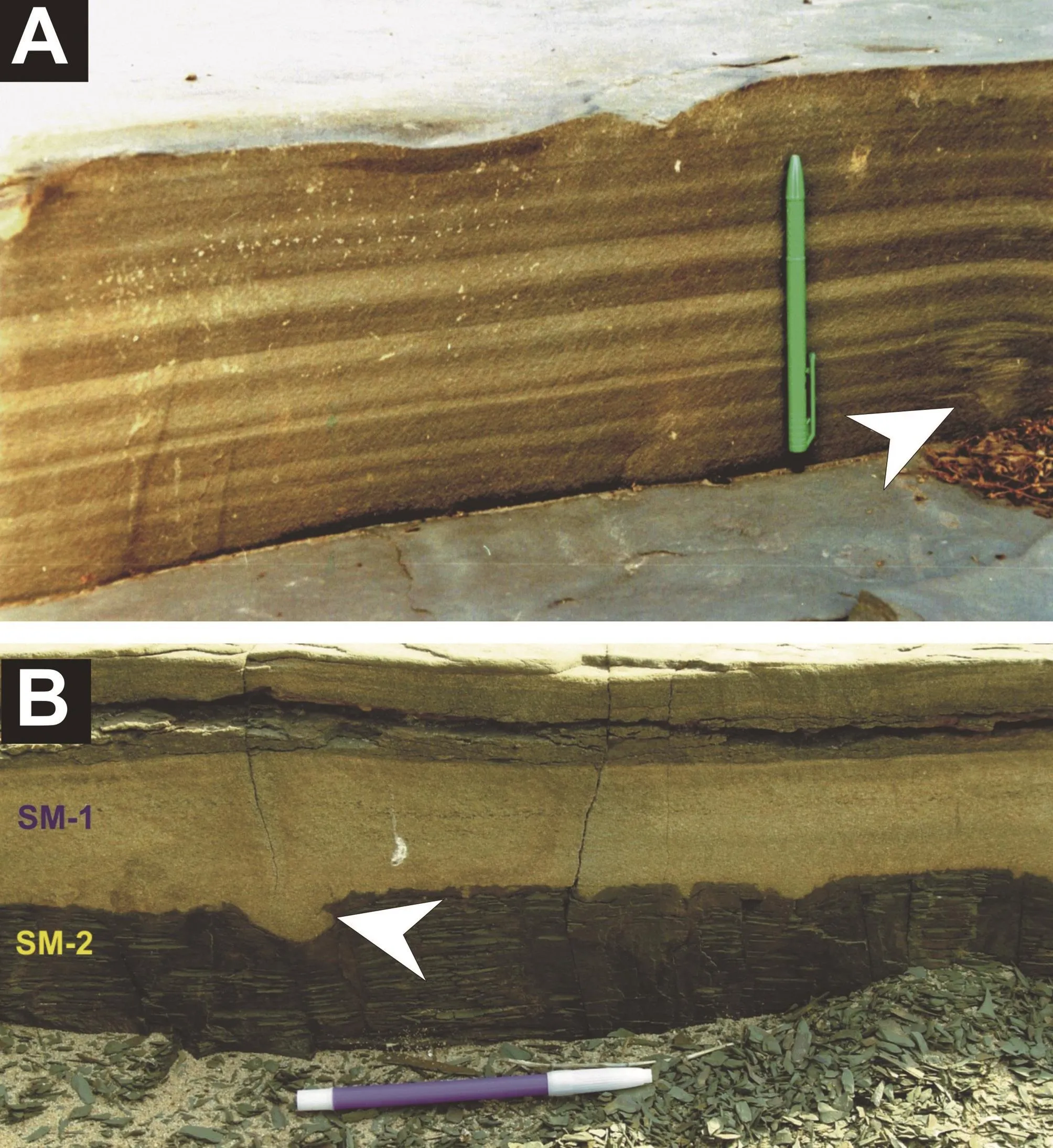
Figure 9 A-Field exposure of the sandstone-siltstone-mudstone interbedded facies, showing fine-grained sandy siltstone grading upward to dark colored mudstone. Length of the pen is 14.2 cm.Note the presence of trace fossils (arrow marked); B-Dark, massive mudstone of SM-2, overlain by sandstone-siltstone-mudstone interbedded facies (SM-1), Ajay River section. Length of the pen is 14.5 cm. Note the presence of small sole marks (arrow marked) at the base of the sandstone beds.
6 Ichnological attributes
6.1 Ichnofabric
Ichnological study reveals the presence of 12 ichnogenera and 15 ichnospecies, viz., Planolites beverleyensis,Planolites annularis, Paleophycus heberti, Skolithos isp.,Teichichnus rectus, Rhizocorallium irregulare, Rhizocoral?lium jenense, Cylindrichnus, Scalarituba isp., Psilonichnus isp., Taenidium serpentinum, Zoophycos isp. (spiral-type),Zoophycos isp. (flat-type), and Nereites isp. within the studied Talchir succession (Bhattacharya and Bhattacharya, 2007). In addition, some escape structures (Fugichnia)and linear surface trails are also recorded. The studied trace fossils predominantly occur within the millimeter- to centimeter-thick storm-laid beds of the sandstone-siltstone-mudstone interbedded facies (SM-1), and in minor amounts within the thickly bedded sandstone-mudstone interbedded facies (CSM-4) and the massive mudstone facies (SM-2). These ichnoforms are grouped into five ichnoassemblages, viz., Planolites assemblage, Scalarituba-Teichichnus assemblage, spiral Zoophycos-Rhizocorallium assemblage, Nereites assemblage and flat type Zoophycos assemblage, based on their lithological affinities. Probable trace makers include annelids and worms, along with a few crustaceans in most cases (Bhattacharya and Bhattacharya,2007).
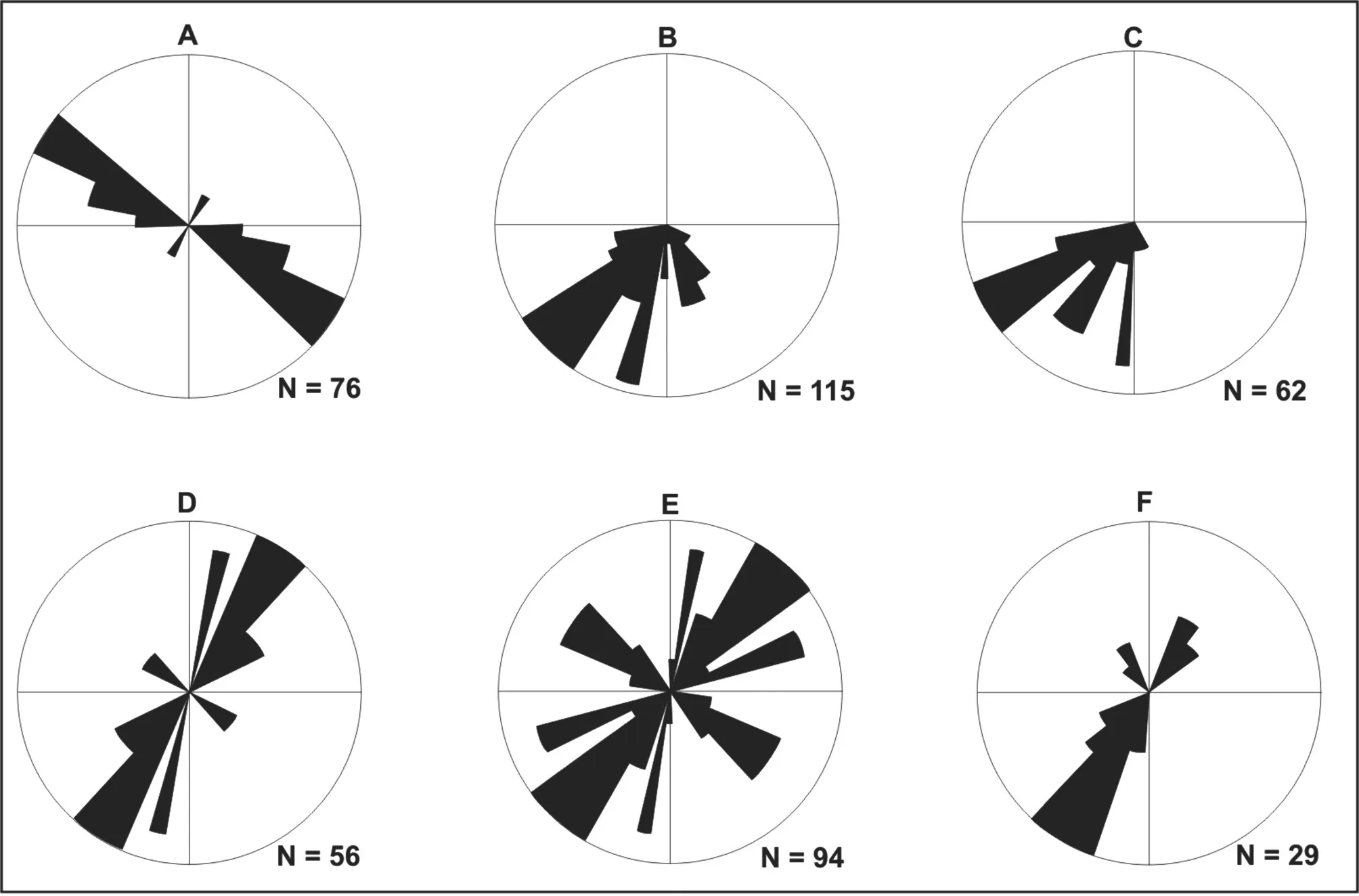
Figure 10 Rose diagrams showing plots of different linear directional elements from sediments of the Talchir Formation, Raniganj Basin.A-Trend of the crest-lines of wave ripples; B-Palaeocurrent directions obtained from foresets of current ripples and combined-flow ripples; C-Trend of palaeochannel axes and trough axes; D-Orientation of gutter casts; E-Orientation of groove marks; F-Orientation of prod marks. N = Total number of measurements.
The studied trace fossils are mostly shallow marine. The studied ichnites are smaller in size, and show relatively low ichnodiversity and bioturbation intensity in comparison to ichnofabrics of recent shallow and marginal marine environments. The basal and the middle part of the sequence containing ice-rafted debris (IRD) shows no bioturbation.Very low to medium bioturbation is generally observed in the rest of the succession. Extensive bioturbations at some intervals resulted in non-descript mottling forms, where identification of individual ichnotaxa is not possible (Bhattacharya and Bhattacharya, 2007).
6.2 Palaeoecological implications
Within the heterolithic facies (SM-1), minor but significant changes of ichnodiversity with changes in sediment size and bed thickness indicate fluctuations in energy conditions during storm sedimentation. Rarity of trace fossils with few Fugichnia, Cylindrichnus, Skolithos isp. and Psilonichnus isp. in thick, massive, plane-laminated and hummocky cross-stratified sandstone beds manifest rapid sedimentation by initial high-energy storms. Dominance of suspension feeders (viz. Skolithos), equlibrichnia (viz.Teichichnus rectus) and deposit feeders (viz. Scalarituba isp., Palaeophycus heberti, spiral Zoophycos isp., Rhizo?corallium irregulare, Rhizocorallium jenense, Planolites annularis, Planolites beverleyensis) of the Planolites assemblage and the Scalarituba-Teichichnus assemblage within thinner sandstone-mudstone interbeds suggest a consecutive drop in storm-energy, easy availability of nutrients and optimum oxygen fugacity near the sedimentwater interface. Teichichnus rectus, Nereites isp. and Rhizocorallium jenense on the other hand are restricted to mud-dominated thicker layers with thin siltstone interlayerings. Higher bioturbation intensity in these sediment intervals implies a decrease in the depositional energy and prolonged quiescent phases that led to a wide colonization window. The basinal mudstone facies (SM-2) characteristically contains flat type Zoophycos isp., a probable chemichnia (chemosymbiotic), suggesting very low energy conditions, fine sediment size, poor availability of detrital nutrients and low bottom oxygen conditions. Strong lithofacies affinity of the studied ichnites with restricted diversity and smaller burrow dimensions (established in Bhattacharya and Bhattacharya, 2007) indicates low-salinity conditions (Bromley, 1996). Predominance of presumed annelid/worm traces (Table 1), which can thrive in lowsalinity conditions, gives a strong support to such views(Collinson et al., 1994; also see Bhattacharya and Bhattacharya, 2007). In the Talchir ice-marginal sea, influx of ice-melt freshwater during deglaciation caused lowering of marine salinity (Bhattacharya and Bhattacharya, 2007;Chakraborty and Bhattacharya, 2005). Absence of body fossils including shelly taxa and the predominance of annelids/worms also depict relatively cold climatic conditions in the depositional realm (Bhattacharya and Bhattacharya,2007).
7 Discussion on palaeogeography
The results obtained from the detailed facies analysis supported by the study of ichnofossils are integrated finally to deduce a generalized palaeogeographic model for the Raniganj Basin during Talchir sedimentation (Fig. 11).
Data obtained from glacial striations on the basement,overall facies sequences, orientation of the sole marks,trend of the wave ripple crests and trend of the palaeochannel axes attest that in the Raniganj Basin the palaeoslope and the predominant palaeocurrent directions were SSW-ward. The continental ice sheet in the north was flanked by a shallow sea towards the south. Glacial striations suggest broadly SSW-ward advances of the glacier.Climatic amelioration led glacier melting, fluctuations of the ice-grounding line and finally, retreat of the ice sheet.Storm-laid marine sediments were deposited on the glaciogenic sediments during subsequent transgressive phases. A broad NW-SE trend of the palaeoshoreline of the studied part of the Talchir Sea (possible extension of the Tethys)is deduced from the orientation of the wave ripples present within the storm-laid sandstone/siltstone beds (Bhattacharya et al., 2004). SW-ward thickening of the studied succession indicates shore-normal offshore-ward sediment dispersals. Further in-depth analysis of the Talchir sediments added finer details to the palaeoenvironmental and palaeoecological facets, which helped to frame a comprehensive palaeogeographic model of the Raniganj Basin during Permo-Carboniferous time (Fig. 12).
The ice-covered landward part was characterized by glaciogenic sediments, which were reworked and subaqueously emplaced in front of the ice-grounding line along the basin periphery. Decoupled ice sheet and floating icebergs contribute dropstones to these sediments. Wave-agitated shoreface-shelf sediments overlie these glaciogenic sediments indicating an environmental shift with a gradual sealeve rise. During climatic amelioration, widespread marine transgression caused by glacier melting may have resulted in onlap of the shoreface-shelf sequence over the periglacial sequence. Crustal downsagging related to glacioisostasy may have also triggered marine inundation (cf. Gray,1996; also see Bhattacharya et al., 2005). Several fining-up deglaciation sequences within these onlapping sediments record repeated glacier advances and retreats before its final withdrawal from the basin (Bhattacharya and Bhattacharya, 2014). With gradual warming of the climate, the ice sheet completely retreated to the continent. Supply of huge amounts of ice-melt water into the basin resulted in further eustatic sea-level rise.
With climatic warming, local organic activities flourished in the studied marginal marine area. Annelids, worm-like organisms, crustaceans and a few mollusks were dominant amongst the benthic community (Bhattacharya and Bhattacharya, 2007). Fluctuations in storm energy controlled the nature of the sediment supply, availability of nutrients and the supply of bottom-oxygen, which largely influenced the habitat and life-style of the organisms. Ethological response of the organisms to these ecological control parameters governed the ichnofabric pattern and ichnodiversity in the study area. Low marine salinity due to the influx of freshwater during deglaciation and relatively cold climatic conditions in the ice-marginal sea resulted a stressed environment. In such an environment the organisms produced an impoverished ichnodiversity in comparison to the normal marine ichnocoenoses of Permo-Carboniferous time.
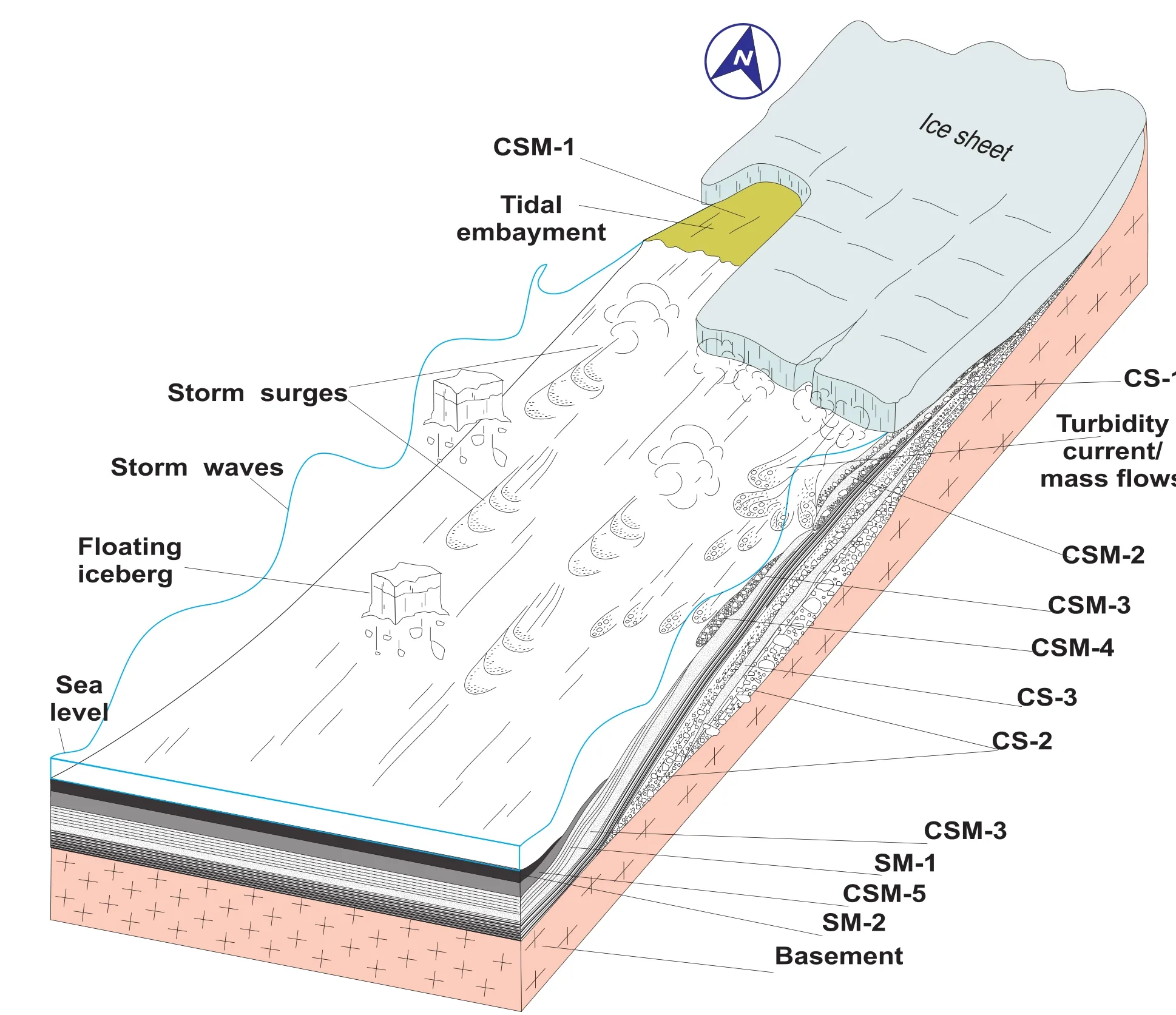
Figure 11 Generalized glaciomarine depositional model of the Talchir depositional system, Raniganj Basin, India.
Complete removal of the ice sheet during climatic amelioration led to basinal exhumation (cf. Bhattacharya et al.,2005; Coward et al., 1991; Giese and Jacobshagen, 1992;Gray, 1996; McCabe and O’Cofaigh, 1996). Differential crustal uplift due to post-glacial isostatic rebound forced rapid regression and horst-graben depositional settings that ushered in alluvial fan-fluviatile sediments of the Karharbari Formation and the coal-bearing Barakar Formation.
Such evidence of Permian glaciation-deglaciation and consequent GIA (glacial isostatic adjustments) is in conformity with modern glacial theory and matches with similar changes that took place during the Last Glacial Maximum (LGM), approximately 21,000 years ago (Peltier,1999). Initial significant sea-level rise over the ocean basins essentially everywhere on the Earth’s surface due to the collapse of large continental ice sheets during deglaciation was followed by delayed viscoelastic response of the Earth’s crust in glaciated regions (e.g., Canada, Northwestern Europe, Siberian Arctic, etc.). This led to a gradual fall in relative sea level at a rate proportional to the ongoing postglacial rebound of the crust (Peltier, 1999; Whitehouse et al., 2007). Such changes due to GIA are non-negligible even at sites that are away (“far-field”) from the glaciated region, primarily to ensure gravitational equipotential of the Earth’s surface (the geoid) (Peltier, 1999).
8 Conclusions
The Talchir Formation, the basalmost unit of the Gondwana Supergroup in Peninsular India, was earlier interpreted as glacial, glaciofluvial, glaciolacustrine or glaciomarine sediments. The present sedimentological and ichnological analysis of the rocks of the Talchir Formation of the Raniganj Basin, India, however, interprets them as ice-marginal shallow marine sediments.
1) Detailed sedimentary facies analysis in the framework of glacial-periglacial processes, assessment of cyclicities and evaluation of sequence stratigraphic architecture reveal repeated glacial advance-retreat cycles with shifts in the palaeoshorelines of the Raniganj Basin during Talchir sedimentation.
2) The basal part of the succession represents glacial maxima and post-glacial meltout phases. Open marine storm-laid sedimentation accompanied by tide-storm interactions controlled sedimentation during glacier retreat with landward encroachment of the sea.
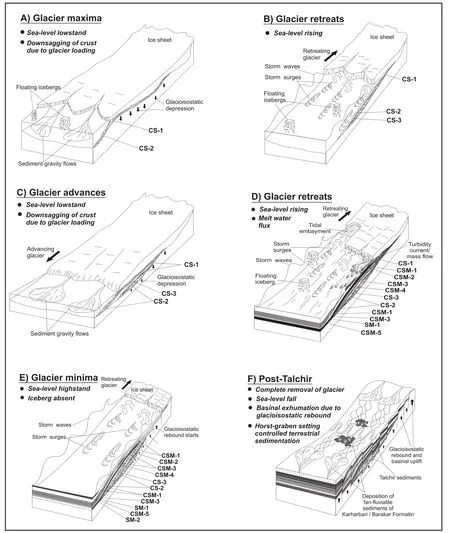
Figure 12 Basin evolution pattern during the Talchir sedimentation in the framework of glacial advance-retreat cycles under deglaciation. A-The glacier at its maximum extent, followed by repeated B-Glacier retreats and C-Glacier advances; D-Continuous retreat of the glacier led to a glacier minimum phase in E-When the ice sheets retreated conspicuously; F-Post-Talchir glacioisostatic adjustment of the basin led to deposition of coal-bearing Gondwana sediments.
3) Ichnological study, on the other hand, simulates the true nature of sediment-animal interaction in the framework of ambient sedimentation patterns, local hydrodynamic conditions, supply of nutrients and oxygen, salinity and temperature conditions, and thus indicate minor changes in palaeoecological controls.
4) The postulated depositional model indicates that sedimentation was controlled by changes in relative sea level related to glacial isostatic adjustments (GIA) during the Late Paleozoic glaciation-deglaciation and confirms well with the modern glacial theory of glaciotectonites and sealevel fluctuation.
Acknowledgements
Authors express their thankfulness to Dr. Santanu Banerjee, Dr. Rajat Mazumder and Dr. Qi-Rui Zhang for constructive comments of the manuscript. Authors are also grateful to the Department of Science and Technology (DST), Government of India, for financial assistance (Grant No. F.5-14/2001(SR-1)).
 Journal of Palaeogeography2015年3期
Journal of Palaeogeography2015年3期
- Journal of Palaeogeography的其它文章
- Sequence architecture of a Jurassic ramp succession from Gebel Maghara (North Sinai, Egypt): Implications for eustasy
- Characteristics of the Paleozoic slope break system and its control on stratigraphic-lithologic traps: An example from the Tarim Basin, western China
- Palaeogeography of a shallow carbonate platform: The case of the Middle to Late Oxfordian in the Swiss Jura Mountains
- 3D palaeogeographic reconstructions of the Phanerozoic versus sea-level and Sr-ratio variations: Discussion
- Reply to comments by G. Shanmugam(2015) and A. J. (Tom) van Loon (2015)on “3D palaeogeographic reconstructions of the Phanerozoic versus sea-level and Sr-ratio variations”
- 2nd International Palaeogeography Conference October 10–13, 2015, Beijing, China
